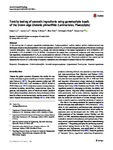Toxicity testing of cosmetic ingredients using gametophyte beads of the brown alga Undaria pinnatifida (Laminariales, Phaeophyta)
| dc.contributor.author | Brown, Murray | |
| dc.date.accessioned | 2019-02-07T14:09:00Z | |
| dc.date.issued | 2019-01-03 | |
| dc.identifier.issn | 0921-8971 | |
| dc.identifier.issn | 1573-5176 | |
| dc.identifier.uri | http://hdl.handle.net/10026.1/13275 | |
| dc.description | File embargoed until 03.01.2020 (publisher’s embargo period). | |
| dc.description.abstract |
A 6-h toxicity test of cosmetic ingredients (methylparaben, 2-phenoxyethanol, sodium dodecyl sulfate, triethanolamine) was developed, based on the photosynthetic maximum quantum yield (Fv/Fm) of immobilized gametophytes of the brown macroalga Undaria pinnatifida. From calculated EC50 values, the toxicity ranking of the tested ingredients is: SDS (0.0060%) > MP (0.0634%) > 2-PE (0.2418%) > TEA (3.7023%). Compared to the results from conventional endpoints with other ecotoxicity test organisms, measurements of Fv/Fm is a more sensitive indicator of the toxic effects of cosmetic ingredients. The present technique is simple, rapid, practical, accurate, and requires little space to carry out. This novel method will be a useful tool for assessing the toxicity of a wide range of cosmetic ingredients once the respective sensitivities are fully established. | |
| dc.format.extent | 2011-2023 | |
| dc.language | en | |
| dc.language.iso | en | |
| dc.publisher | Springer Verlag | |
| dc.rights | Attribution-NoDerivatives 4.0 International | |
| dc.rights | Attribution-NoDerivatives 4.0 International | |
| dc.rights.uri | http://creativecommons.org/licenses/by-nd/4.0/ | |
| dc.rights.uri | http://creativecommons.org/licenses/by-nd/4.0/ | |
| dc.subject | Phaeophyceae | |
| dc.subject | Undaria pinnatifida | |
| dc.subject | Immobilized gametophytes | |
| dc.subject | Alginate bead | |
| dc.subject | Toxicity test | |
| dc.subject | Cosmetic ingredients | |
| dc.title | Toxicity testing of cosmetic ingredients using gametophyte beads of the brown alga Undaria pinnatifida (Laminariales, Phaeophyta) | |
| dc.type | journal-article | |
| dc.type | Journal Article | |
| plymouth.author-url | https://www.webofscience.com/api/gateway?GWVersion=2&SrcApp=PARTNER_APP&SrcAuth=LinksAMR&KeyUT=WOS:000469393600047&DestLinkType=FullRecord&DestApp=ALL_WOS&UsrCustomerID=11bb513d99f797142bcfeffcc58ea008 | |
| plymouth.issue | 3 | |
| plymouth.volume | 31 | |
| plymouth.publication-status | Published | |
| plymouth.journal | Journal of Applied Phycology | |
| dc.identifier.doi | 10.1007/s10811-018-1669-x | |
| plymouth.organisational-group | /Plymouth | |
| plymouth.organisational-group | /Plymouth/Faculty of Science and Engineering | |
| plymouth.organisational-group | /Plymouth/REF 2021 Researchers by UoA | |
| plymouth.organisational-group | /Plymouth/REF 2021 Researchers by UoA/UoA06 Agriculture, Veterinary and Food Science | |
| plymouth.organisational-group | /Plymouth/Research Groups | |
| plymouth.organisational-group | /Plymouth/Research Groups/Marine Institute | |
| dcterms.dateAccepted | 2018-10-18 | |
| dc.rights.embargodate | 2020-1-3 | |
| dc.identifier.eissn | 1573-5176 | |
| dc.rights.embargoperiod | Not known | |
| rioxxterms.versionofrecord | 10.1007/s10811-018-1669-x | |
| rioxxterms.licenseref.uri | http://creativecommons.org/licenses/by-nd/4.0/ | |
| rioxxterms.licenseref.startdate | 2019-01-03 | |
| rioxxterms.type | Journal Article/Review |



